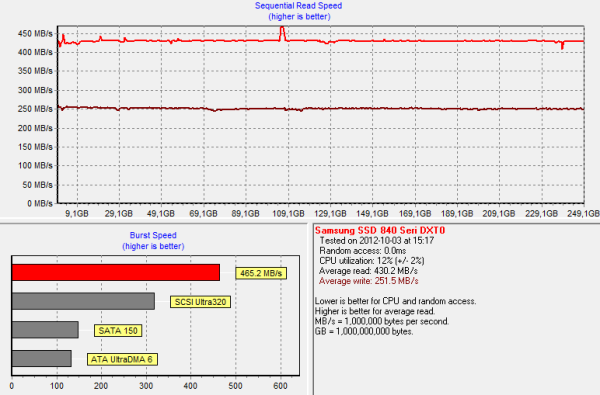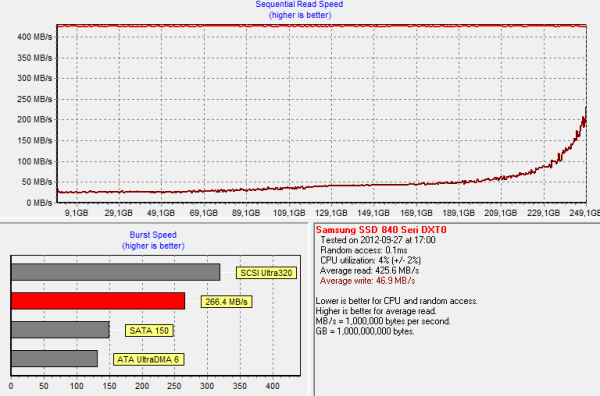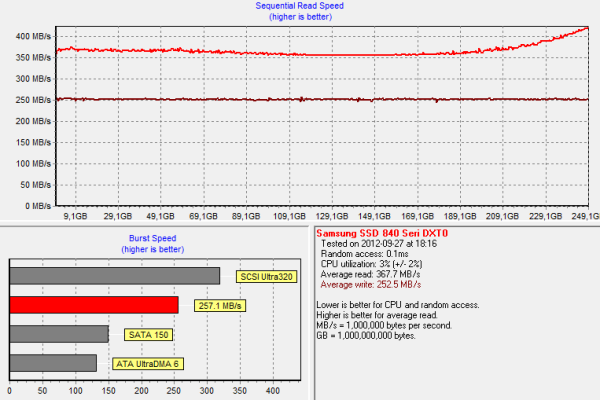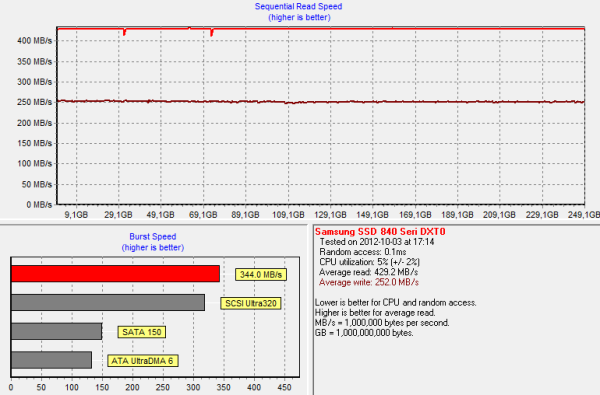Samsung SSD 840 (250GB) Review
by Kristian Vättö on October 8, 2012 12:14 PM EST- Posted in
- Storage
- SSDs
- Samsung
- TLC
- Samsung SSD 840
Performance Over Time & TRIM
For starters, I ran HDtach on a secure erased drive to get the baseline performance:
Next I secure erased the drive again, filled it with compressible data and proceeded with torturing it for 20 minutes with compressible 4KB random writes (100% LBA space, QD=32):
Ouch, performance takes a big hit. Usually 20 minutes isn't enough to put 256GB drives on their knees but it definitely is for the 840. Write speed drops to as low as 25MB/s, although it's nearly restored before all user-accessible LBAs have been filled. The way to avoid this worst case state is to keep as much free space on your drive as possible. We typically recommend around 20%, however with TLC NAND it might be advisable to bump that up to 30%. The 840 Pro will be a better option for heavy write workloads already due to its higher endurance.
To see how idle time is able to restore performance, I let the drive idle for 50 minutes:
Write speed is fully restored but for some reason, read speed is fluctuating. The drop isn't huge as we are still talking about +350MB/s at all times, but it's interesting and a bit odd to see this kind of behavior since read speed was ~425MB/s after torture.
Finally I secure erased the drive again, filled it, tortured for 20 minutes and TRIM'ed it:
Again we see some weird behavior as write speed is not fully restored after TRIM. It does get to 250MB/s at the end of the HDtach run, but the starting performance is only 150MB/s. Keep in mind that I TRIM'ed the drive right after the torture; I didn't run HDtach in between like we often do but a functioning TRIM should still fully restore performance. Remember that TRIM is still just a suggestion—it's up to the controller to prioritize TRIMed LBAs for garbage collection. Given the higher program/erase latencies with TLC NAND it's entirely possible that the 840's garbage collection routine is just slower than we're used to seeing. Another possibility is that with the fewer number of P/E cycles, the 840 is just very conservative about using them when it's not stricly necessary (e.g. ignoring some of the TRIM "suggestions").
As a final test, I TRIM'ed the drive again and ran HDtach:
And now performance is what it should be. This is mostly due to sequential writes because at the end of the previous HDtach run, write performance was already at 250MB/s.















86 Comments
View All Comments
Kristian Vättö - Tuesday, October 9, 2012 - link
Samsung will be releasing Magician 4.0 later this year and we are definitely going to do an article about it. I tried to get a beta version of it but Samsung wasn't willing to send us one, yet. Magician 3.2.2 that comes with the 840 is the same that's available for the 830, so I didn't find it that important to cover.But you are right, we need to cover the software side more as well because it will also drive manufacturers to make their own SSD tools.
P.S. Try installing Ubuntu to a USB stick (just use UNetBootin) and then use hdparm commands (see below) to secure erase the SSD.
sudo hdparm --user-master u --security-set-pass password /dev/sdX
sudo hdparm --user-master u --security-erase password /dev/sdX
"password" is whatever you choose as the password and "X" is the drive (you can see which it is in Disk Utility)
Impulses - Monday, October 8, 2012 - link
At one point in the article you mention 830 users would at least wanna upgrade to the 840 Pro if they aren't gonna wait for next gen drives... I kinda thought the Pro qualified as next gen, with the vanilla 840 being more of a side grade from current gen drives. So what would you consider or expect from a next gen drive?KAlmquist - Tuesday, October 9, 2012 - link
One thing I've been wondering is what voltage the controller uses. I can't identify every component on the board, but I don't see anything that looks like a voltage regulator. It seems kind of crazy to run a chip with three processor cores at 5 volts, but I guess it's possible.Death666Angel - Tuesday, October 9, 2012 - link
Loved the review. I'm really looking forward to more data on the DSP usefulness inside SSDs, could be a huge advantage (though I don't worry about going through my P/E cycles at home).With SSDs, we are at a point similar to GPUs and CPUs where I don't understand upgrading from generation to generation. Unless you have a very specific usage case and can make great use of the better speed (video/picture editing or something equally I/O intensive), I don't think a 840 Pro will feel that much faster than a 830.
I'm still rocking a first gen Agility 60GB in my (ULV) notebook and a Vertex2 120GB in my desktop and they feel plenty fast, especially those times when I'm at a friends PC with only mechanical storage.
I might upgrade to a 830 or 840 (non Pro) when the prices have dropped for the 830 or stabilized for the 840 (I don't like paying for launch pricing). :D
And I finally got my brother to go to SSD storage, too! He'll either get a 512GB 830 or 2x256. Does anyone know why 256GB usually has the best price/GB instead of the 512GB drives? Considering the cost for casing, PCB, controller etc. stays the same, I would expect the 512GB to have better pricing/GB. Do they need to go with more dense packages which are more expensive?
name99 - Tuesday, October 9, 2012 - link
I agree completely.I've said before that the current emphasis on performance over everything else is as stupid as Intel's Pentium4 philosophy. Devices have to become more balanced if they want to sell better.
In particular the current atrocious write power draws for these devices mean that they will not sell in the external drive market --- they can't be fully powered by USB2 and
- no-one wants a drive that needs two USB connections because it's clumsy and it uses up limited USB slots
- saying it can be fully powered by USB3 is not good enough because, for the near-term future, people want to share drives between USB2 and USB3 computers.
Of course MOST, but not all, the external drive market is about capacity, not speed. However each time SSD capacity doubles, a larger portion of the external drive market makes sense; AND power is not only an issue for the external market. The higher you set your peak power draw, the less your flash appeals to Ultrabook manufacturers.
Just remember Pentium 4 and its power draw, and compare to Intel trying to get Haskell to run at <10W nowadays. Balance matters, and current flash manufacturers seem to be far too unbalanced compared to the requirements of most users.
(It would be fascinating, for example, if we learn that the flash in the next round of iOS devices, or even MacBooks, was designed in-house by Apple because they were not satisfied with the power vs performance choices that were being made by the major flash manufacturers. Remember --- Apple bought Anobit...)
moadip - Tuesday, October 9, 2012 - link
does the 830/840 family support AES encryption? Want to buy one of those but there is no official word on any support for this. Is anyone of you guys/girls using them in that way?Kristian Vättö - Tuesday, October 9, 2012 - link
840 and 840 Pro both support 256-bit AES encryptionmoadip - Tuesday, October 9, 2012 - link
what about the 830?Kristian Vättö - Tuesday, October 9, 2012 - link
I'm not 100% sure but as far as I know, only the OEM/enterprise version (i.e. PM830) supports encryption, the consumer 830 doesn't.MrSpadge - Tuesday, October 9, 2012 - link
What an amazingly well balanced drive! Currently it's more expensive than the 830 at similar capacities, but as soon as 21 nm yield ramps up (and prices are adjusted) this will probably be one of the best or maybe the best consumer SSD on the market.